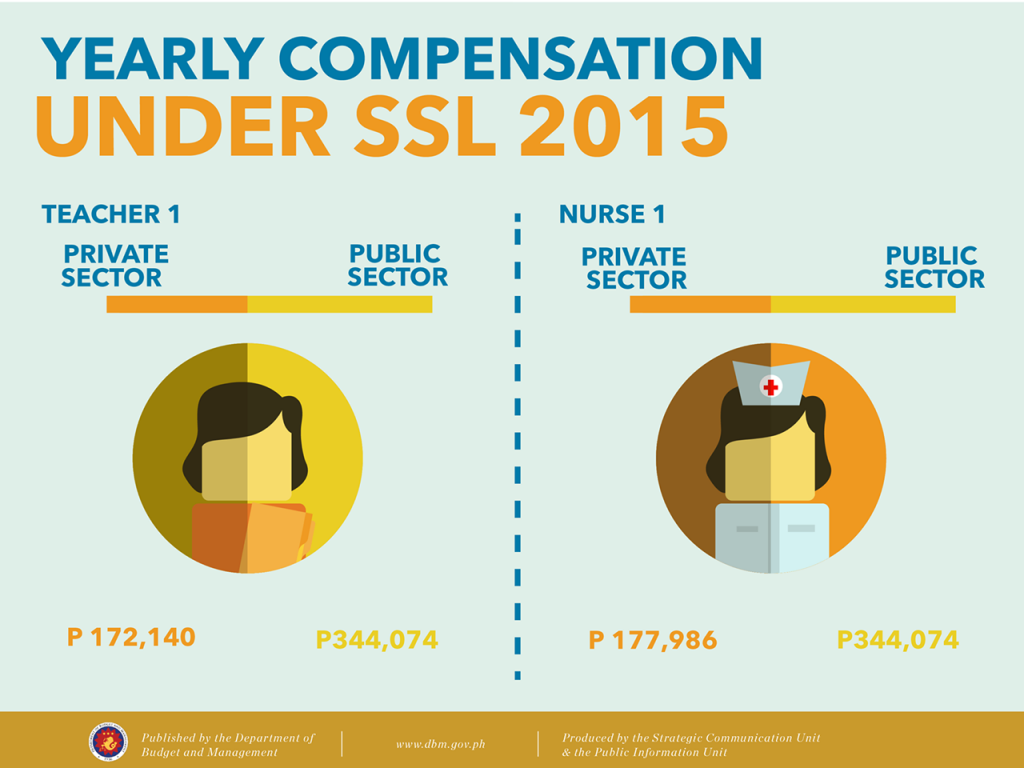According to the Department of Budget and Management (DBM), Public school teachers and nurses will be paid twice as much compared to their private counterparts under the proposed Salary Standardization Law of 2015 (SSL 2015).
“Our study revealed that if we compare the median of the market to the median of SSL 3 rates, public school teachers and nurses are paid much higher in government than in the private sector,” Budget Secretary Florencio “Butch” Abad said.
In the private sector, the positions of Teacher I to III are paid P13,135. The government pays P19,218 for Teacher I position, or 146 percent of the market. For Teacher II positions, the government pays P20,660 or 157 percent of the market. For Teacher III positions, the government pays P22,209 or 169 percent of the market.
Abad said SSL 2015 will increase Teacher I salary to P20,754; Teacher II to P22,938; and Teacher III to P25,232. This will make their monthly pay twice more than their private sector counterparts.
“Under SSL 2015, the total annual guaranteed compensation of Teacher I will be P329,556, up from the current P280,137. Teacher II will get P360,132 from the current P298,220, while Teacher III will receive P392,248 from the current P317,668. This annual guaranteed compensation does not include the PBB, which is contingent on performance and is equivalent to 1.25 month’s salary for SG 11-24. As Teacher I-III is ranked as SG 11-13, that is an additional 1.25 month’s pay for Teacher I to III positions” Abad said.
Meanwhile, the budget chief pointed out that private sector nurses receive pay ranging from P13,033 (Nurse I), P14,083 (Nurse II), to P22,125 (Nurse III). Their government counterparts receive higher salaries with P19,218, P25,878, and P35,207 respectively. Under the SSL 2015, the total guaranteed compensation of Nurse I will go up to P344,074, while Nurse II will receive P485,670 and Nurse III will get P710,804.
“The plan is not to raise the basic salaries alone. We want government compensation to become competitive with the private sector, specifically to bring compensation to at least 70 percent of market rate. Our study found that while the pay of sub-professional workers in government matches or even exceeds those of their private sector counterparts, professional workers get as low as 41 percent of market rates as they move up the ladder. Middle managers, comprised of directors, only get more or less a third of what their counterparts in the private sector get; while executives are paid only about a quarter to a third as much,” Abad said.

“Overall, government pay is 45 percent below market. SSL 2015 will further enhance the market position of SG 1-7 since they will be at 4 percent to 54 percent above market. SG 8-17 will be competitive to the market at 72 percent to 98 percent of the market. SG 18-24 will be at 70 percent of the market. More than a proposal for a salary increase, SSL 2015 is an advocacy to further improve government service. With competitive compensation, we intend to bolster the recruitment of agencies that need to fill up vacancies in senior technical and middle management positions. There are agencies that have been having difficulty in recruiting and retaining senior technical staff/middle managers,” he pointed out.
The number of unfilled positions in government is 191,988 or 12.53 percent of total authorized positions. The proposed compensation plan is composed of across the board salary increase plus a mid-year bonus equivalent to one month basic salary and the new Performance-based Bonus (PBB) as an added bonus contingent on performance. The mid-year bonus, in addition to the present year-end bonus or 13th month pay, will account for an 8 percent increase in annual salary. The PBB is equivalent to 1 to 2 months basic salary or an 8 to 16 percent increase depending on the position.
– From the Department of Budget and Management